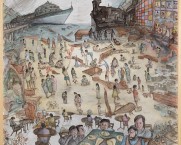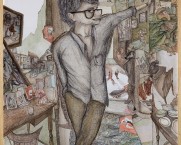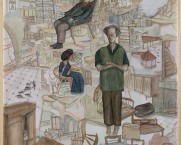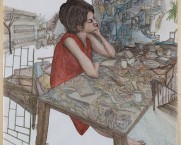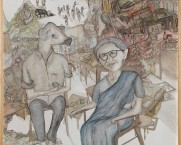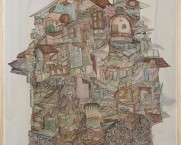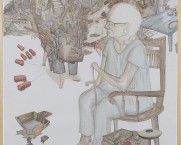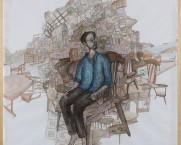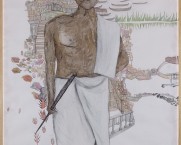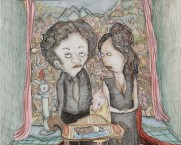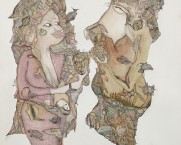C&L Shows
Transparent Things
Nityan Unnikrishnan
2015
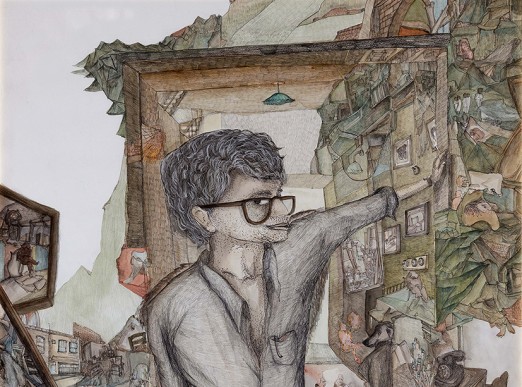
Overview
“When we concentrate on a material object, whatever its situation, the act of attention might lead our sinking involuntarily into the history of that object. Novices must learn to skim over matter if they want matter to stay at the exact level of the moment. Transparent things, through which the past shines!”
~ Chapter 1, Transparent Things (1972)
by Vladimir Nabokov
~~~~
It was at a furniture factory in Palakkad that Nityan Unnikrishnan first encountered the idea that everyday things become transparent because they are overlooked, until you look, and look again. That acquaintance took place in the company of his grandfather. Years later he met the idea again, this time in the jugular world of Vladimir Nabokov. This third solo exhibition of pen, ink, and watercolour on paper is a dialogue with Nabokov’s novel, Transparent Things.
Connections become clearer by going some 10º north of the equator in south India, to a moment when the artist was a boy.
Palakkad is a district in Kerala that borders Coimbatore in Tamil Nadu to the east, and the Silent Valley biosphere to the north. In the 1970s and 1980s, on an ancestral property located near Marutharode Panchayat in Palakkad, there was a carpentry workshop that produced simple wooden furniture. It was Nityan’s grandfather’s. Nearby on the same grounds, by a pond teeming with fish was the family house fronted by a vivid blue portico under the eaves. It was a deliciously picturesque place. Mango, teak, and cashew nut trees sprung tall out of laterite earth. Paddy fields beyond the raised rim of the pond sprawled in a great rectangle to the north.
During his summer holidays, Nityan, a young Calicut native gladly visited his grandparents at this house. The disciplinarian order of school life seemed remote during these sylvan months. But under his grandfather’s instruction he would also count the harvest of mangoes and coconuts, wash the car, and when he was old enough drink deep of his grandfather’s secrets of how to build.
In time, the boy went to college where he failed at physics miserably, perhaps because his old ardour for building and furniture held fast. That was a good thing. It now stories what he draws and paints: derelict facades, defunct ships, old people, wobbly chairs. It also fuels that great part of his pictures in which joining disconnected bits of memories is mostly about getting impossible geometries to work.
~
Nityan’s pictures tunnel relentlessly through his family’s association with now-impoverished Kerala clans, an era of intellectuals whose work may well be forgotten, radicalized politics gone soft, and the fiery discourse of Naxalite activism that once spurred an entire generation of youth in the 1950s and 1960s. A frank admiration for American author Raymond Carver, particularly how his dirty realism achieves, as Carver might have said of good fiction, “a bringing of news from one world to another”, exerts on the artist an equal spell.
The juice that animates this archive comes from colour taking a backseat. The works’ most vivid instances – dark coral red, azure blue, and brilliant moss green – are drained of their obvious intensities. Looking as if sun-bleached or milk-distilled, or sometimes dusted with dark talcum powder, they reveal, in this respect, that Nityan might well be a closet Brutalist. He focuses on drawing to the surface material and emotive textures of motifs. Colour functions logically. A burst of colour has to do with the presence of a moment or a person in the image that justifies its inclusion. It could be a figure’s pulsing red jumper, a mountain’s dappled green, a building’s blue facade, the burnt earth beneath a figure’s feet, the mottled grey skin of an ageing man. It functions like a present but unorthodox keystone that might not centre an image yet allows its bits and bobs to rise and interlock.
~
Before everything is the crux. Whatever the size of the work, Nityan invariably begins with a simple portrait, a mode that echoes his study of Francis Bacon; the British artist frequently chose his friends, lovers, and peers to be the lone subjects of his works. Favouring a blocky portrait orientation, he draws a sizeable figure at the centre of the picture plane. This is usually someone central to the cultural biographies that fascinate him. The point of departure could be anyone from his father and his father’s intellectual circle to erstwhile Naxal frontrunners such as K. Venu, Kunnikkal Narayanan, and Mandakini a.k.a. Ma, Nandanar the Malayali fantasist of children’s stories who also wrote novels about life in the Indian army, and Carver’s wife, the poet Tess Gallagher.
Semi-fictional personae resulting from these citations are then paired with precisely those phenomena that modern redevelopment replaces or consciousness neglects: furniture, buildings, a beloved storybook character, Kerala’s horticultural splendour, and love. Around the human fulcrum, it is they that make the picture’s armature. This may include one-time cameos such as red buses on a leash, a framed painting on a wall behind a seated figure, or a jewel-red pomegranate on a table. But some special imagery repeats erratically across Nityan’s visual lexicon. Lifetime seats are blocked for leitmotifs of ruined piers, large and small fish, blue tabletops, boats, tatty balustrades, old men, and the folkloric Keralan shape-shifter known as Odiyan. Notably, few of these secondary images have a chiselled individuality. They are more likely to abut one another and perch precariously riveted to each other’s edges, such as to obscure where one sub-plot begins and ends.
~
Let it be said, Nityan’s pictures are not about salvaging fragments threatened by invisibility into the hard, observable things, what Nabokov ironically called ‘transparent’ in his novel. They are notes on a kind of thing theory, learned in Palakkad, tweaked by his own response to the writer. Call them an attempt to build the unbuildable, not least because what was once well built, and loved, is now near gone. Some things will remain half-obscured. Some will remain tectonically unsound. In accord with this unfair distribution of heft in things, there exist subtle shifts in the pictures’ surface tones, between limpid, vitreous, subfusc, and opaque. That Nityan works iteratively also explains this effect. Inked images of clear, outlines, typically containing either stippling or a fine mohair-like fill, are combined with films of watercolour laid one atop the other, with repeats. The resulting variation in tone contributes to the work’s overall visual paradigm—that of detail combined with change. So, more than complete stories the pictures are closer to construction sites. Their look of work in progress, their open-ended quality, is what keeps the pictures honest. It balances the artist’s rather crackpot attempt to construct something whole out of bits and pieces that never belonged to each other, and might never do, except here.
~ Prajna Desai

